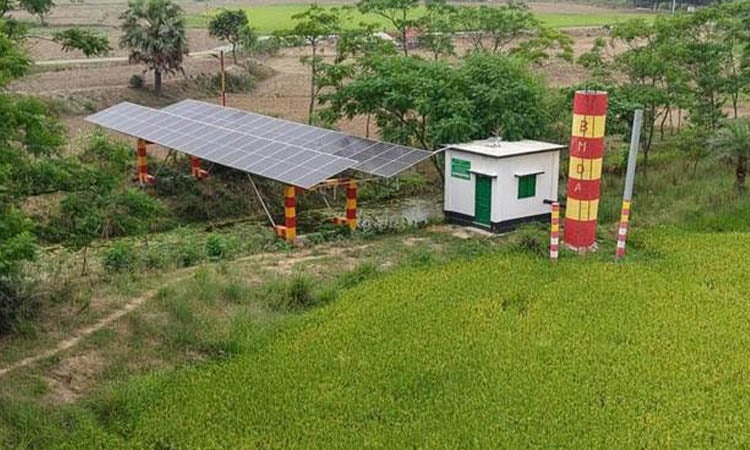News Flash
News Flash

By Md Aynal Haque
RAJSHAHI, Aug 11, 2025 (BSS) – The contributions of the Barind Multipurpose Development Authority (BMDA) to the Rajshahi Barind region have been multifaceted, leading to significant advancements in agricultural productivity, water resource management and overall socio-economic development.
It has significantly contributed to the socio-economic development in 135 upazilas under all 16 districts in Rajshahi and Rangpur divisions through various initiatives, primarily focusing on agricultural development and water resource management.
The BMDA's work helped transform the region into a more productive agricultural area and improving the livelihoods of its people.
According to available statistics, in the last 2024-‘25 fiscal, the state-owned entity has re-excavated 122-kilometer canal and 56 ponds side by side with constructing 22 cross-dams and installing two river-pontoons and 56 irrigation machines driven by solar-power.
"We have also installed 450 deep-tube-wells, 1,305-kilometer underground pipelines and six foot-over bridges besides producing 500 tonnes of seeds and imparting training to 550 farmers," said BMDA Executive Director Tariqul Islam here recently.
Since its inception in 1987, it has, so far, re-excavated 2,649-kilometer canal and 4,313 ponds, constructed 800 cross-dams and 15,348 underground pipelines, rehabilitated 4,790 deep-tube-wells, produced 8,500 tonnes of seeds and given training to 1,58,302 farmers.
At present, BMDA has been providing irrigation to 6,28,567 hectares of land through operating 15,560 DTWs and 991 low lift pumps, producing around 70.60 lakh metric tonnes of food crops annually.
BMDA has been instrumental in developing irrigation infrastructure, particularly through the installation of deep tube wells (DTWs) and the re-excavation of ponds and canals. This has allowed for increased agricultural production by providing water for irrigation during dry periods.
By providing irrigation, soil scientist Dr Nurul Islam said BMDA has enabled farmers to cultivate multiple crops per year to increase food production and income.
The Barind region, once a drought-prone area, has become known as the "rice bowl of Bangladesh" due to the success of BMDA's agricultural development efforts.
BMDA has focused on efficient groundwater management, particularly in the face of potential water shortages due to over-extraction.
Dr Islam, Principal Scientific Officer of Soil Resource Development Institute (SRDI), attributed that the BMDA has also promoted surface water-based irrigation to reduce pressure on groundwater resources.
It has implemented projects to re-excavate ponds and canals, improving water storage capacity and facilitating irrigation.
By boosting agricultural production and providing access to water, BMDA has contributed to improve living standards and livelihoods for the people of the Barind region.
SRDI scientist Dr Islam said the increased agricultural productivity and income generating activities have helped reduce poverty in the area immensely.
In addition to creating employment opportunities in the agricultural sector and related industries, BMDA has implemented measures to adapt to climate change, including promoting drought-resistant crops and efficient water management practices.
It has also explored ecosystem-based approaches to water management, aiming to balance human needs with environmental sustainability.
Ataur Rahman, a farmer of Pirojpur village under Godagari Upazila, termed the BMDA as a blessing in terms of boosting agricultural production. As a whole, it has transformed the Barind region into food storage in the country.
"We are committed to spread surface water irrigation in the region, particularly in its vast Barind area as we are implementing projects to promote irrigation through pond re-excavation and surface water augmentation," said Shamsul Huda, Additional Chief Engineer of BMDA.
Surface water irrigation appeared to be a best tool to mitigate the gradually mounting pressure on underground water in the drought-prone Barind area having scores of natural water bodies which currently remain in uncared and derelict condition.
He said: "We have a plan of elevating the surface water-based irrigation to 30 percent from the existing 10 percent by 2030 to lessen the gradually mounting pressure on underground water."
Referring to various research findings, Prof Chowdhury Sarwar Jahan of Department of Geology and Mining in Rajshahi University said there are around 10,000 ponds, 200 canals and 10 other big sized waterholes in the Barind areas in Rajshahi, Chapainawabganj and Naogaon districts.
"We have enormous scopes of enriching the surface water resources through proper management of the water bodies," said Prof Chowdhury, who conducted research on both surface and groundwater resources in the drought-prone Barind area.
Citing the instance of Beelbhatia, a vast water body and wetland of around 6,388 acres, at Bholahat upazila in Chapainawabganj, he mentioned that tens of thousands hectares of farmland can be irrigated round the year through using conserved water of the ‘beel’ if it was re-excavated.
There is another four to five kilometer long water body at Rohanpur in Gomastapur upazila of the same district. If it is re-excavated, around 10,000 hectares of land of 25,000 farmers can be brought under surface water irrigation, Prof Chowdhury added.